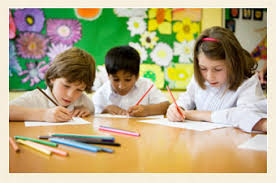Developing Higher Mental Functions
Weekly Series — Developing Young Thinkers

The alarm goes off. Five year old Johnny rolls over, blinks his eyes a few times. He counts to three, slides the covers and springs out of bed. As his feet hit the floor he already knows the six things he needs to do before he makes it to the kitchen. The race is on, how fast can he get dressed, to the bathroom, room cleaned before he sits down to eat. Each morning he tracks his best times on the wall chart.
Even at the age of five, Johnny is on the road to independence. His alarm, schedule and timer are tools that are helping him to develop higher mental functions.
Higher mental functions are deliberate which means they can be controlled by thought and choice.
In the last article Jenny was having difficulty raising her hand to answer questions in a group. She was constantly having to be reminded to wait her turn by the teacher. Her teacher then realized that she could give Jenny a picture of a raised hand (visual support) as a reminder. The picture was a new mental tool that Jenny could use to help her build this new habit.
Instead of the teacher having to “Tell Jenny” to raise her hand, she just pointed to the card. After a few times, Jenny was able to stop and think before talking out of turn. Eventually Jenny would not need the card and the new skill would become automatic for her. She would internalize it the same way that Johnny automatically flies out of bed to race for breakfast.
There are three main benefits to building higher mental tools for children.
Extending the mind’s capabilities.
Extending the mind’s capabilities enables the brain to organize more information than it could on its own. Children will use pencil and paper to organize the steps of a math problem. With practice they start to do the steps in their own brain. Eventually, they can hold the steps in their working memory without having to write the steps down.
Mastering Behavior.
Children can master their emotions and self regulation through the use of mental tools. Self Talk is one of the most important higher mental tools to learn. If children are feeling anxious they can use verbal strategies like counting to 10 to get control of their emotions.
Gaining Independence.
Children learn to use the tools by working with others. With practice they can do them on their own. Eventually, the external tools will become internalized and new habits develop. When this happens they have more brain energy to concentrate on other things as well.
In the case of Jenny, once she has internalized the skill of waiting her turn, she will be able to help others remember how to do it as well. She will then be on her own road to independence.
In the next article we will talk about the specific characteristics of higher mental tools and how to build them.
I hope this was helpful. All your comments and input are greatly appreciated. Don’t forget to follow us on Medium and join our newsletter at daVinci Publishing



